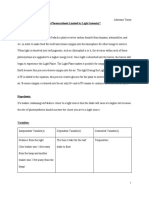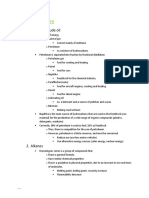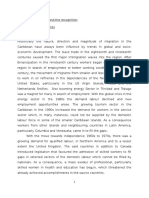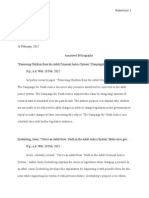Annotated Bibliography
“What types of juvenile punishment have been developed to prevent future crimes?”
By: Sydney Nicole DeVincenzo
February 23, 2020
Buchholz, Maria Mae. “Effectiveness of Restorative Justice Programs in the Prevention of
Juvenile Crime.” ProQuest , North Dakota State University , 2014.
This thesis by Maria Mae Buccholz discusses the effectiveness of justice systems related to
juvenile crime. In the introduction, the focus was pointed towards having empathy and
understanding the actions of the delinquents and their victims. She discussed by doing this, we
can open up with the offender and help them know and understand that what they are doing is
completely wrong and how thier actions can lead them to serious consequences. The minds of
young adults are harder to grasp because their minds are still developing. By talking to them this
early in age, it’s hopeful that they can conclude that they need to stop for the better of themselves
and the community and prevent them from committing any future crimes.
Greenwood , Peter. “Prevention and Intervention Programs for Juvenile Offenders.” Gale
Academic Onefile , Princeton University-Woodrow Wilson , 2008
This reading from Peter Greenwood, who believes that preventing delinquency saves the lives of
young ones being thrown away. It discusses different program models that can be utilized to
offer guidance to juveniles and other young adults who are a first-time offender. These programs
are formed to encourage them and teach them about the negative effects of drug use,
delinquency, early school dropout, etc. Talking and discussing the role of these programs can be
beneficial to our youth society to prevent their lives being wasted and put into incarnation and
walk away from the risk of spending the rest of their life held in prisons, possibly without parole.
Mayeux , Sara. “The Juvenile Detention System Is Broken .” Gale In Context , Gale, a Cengage
Company , 2016.
Sara Mayeux’s writing focuses more on the justice system, which she believes is broken. She
talks about how most of these “delinquents” are being held in such horrible facilities that could
potentially that has a better chance of turning them into more of a criminal than than they were
before they were there. Her definition of delinquency is a development stage, which we can help
these kids through and out of it, or punish them how we do and possibly lead them into a more
violent stage from the torture and anger they are put through where they can be stuck in forever.
She further concludes on this by discussing that these kids’ first offence aren’t serious crimes,
like a homicide or hijacking a car, but crimes began to grow worse around the age of nine ten,
eleven, and maybe twelve. This could result in traumatizing events they have went through in a
�young age that built up such emotion as anger to comit these crimes. She provides different ways
of making a difference, like support groups and therapies for families with kids in these
situations.
NA. “Crime Prevention and Punishment.” Gale in Context , Gale, a Cengage Company , 2011.
The topic review on crime prevention and punishment from the Cengage Company opens on the
statistics of juvenile crime since the 1990s. It discusses the use of violet prevention programs that
are broadcasted in schools and other community environments. However, it states that not all of
these programs are capable of actually stopping juvenile crime, but offers strategies to
furthermore prevent this, like curfews, different community projects, gang resistance and
education training, etc. More on juvenile punishment, this reading state that more juveniles are
being trialed as adults and focus more on punishing them rather than trying out rehabilitation
centers for these delinquents.
Pangnanelli, Enrico. “Adult Sentencing Does Not Deter Juveniles from Crime .” Gale in
Context, Gale, a Cengage Company , 2008.
Enrico Pignanelli discusses that juvenile crime rate has dramatically grown since 1994. He
begins to bring up the fall of the juvenile justice system. The Juvenile and Justice and
Delinquency Act of 2002 had also failed with many delinquents being transferred to adult court
depending on the crime they trialed for. Studies have shown being trialed as an adult has a
negative effect on juveniles and their educational, employment, and social opportunities. Some
people may see punishing them as an adult would be better because it teaches them a more
valuable lesson, it doesn’t stop them from re deferring and can encourage future criminal
activity. She also begins stating that keeping juveniles in the juvenile justice system is beneficial
because there’s many positive characteristics that can lead them to a different direction and
rehabilitation.
Pioppi , Anthony. “A Tale of Two Lives .” Shibboleth Authentication Request, Scholastics, Inc,
15 Sept. 1995, go-gale-
com.proxy039.nclive.org/ps/retrieve.do?tabID=T002&resultListType=RESULT_LIST&searchR
esultsType=SingleTab&searchType=BasicSearchForm¤tPosition&docId=GALE|A17525029&d
ocType=Cover+story&sort=Relevance&contentSegment=ZONE-
MOD1&prodId=AONE&contentSet=GALE|A17525029&searchId=R1&userGroupName=shel4
1774&inPS=true.
This article from scholastic by Anthony Pioppi tells the two completely different lives of two
young juveniles. One was placed in an overcrowded detention center with tight security and
unpleasant conditions where he felt he wasn’t safe, while the other was placed in a facility for
rehabilitation, where he felt safe and secured. Pioppi discusses the lifestyle the two individuals
grew up in. He also discusses their stories and how they got to where they are today. Their
�stories are a great way to look at how the juvenile system treats other’s with more intense
punishment than other’s and the unfairness in the system.
Sukhia , Kenneth W. “Harsh Punishment Is the Best Way to Prevent Juvenile Crime .” Gale in
Context , Greenhaven Press, 2005.
Kenneth Sukhia opens why harsh punishment is the best way to stop crimes with stating the
statistics pf crime and how the United States is the number one nation with the highest
percentage of crime. She discusses many juvenile cases, some brutal, in areas that are most
known for juvenile crime. In most cases, juvenile offenders believe that unless they commit the
crime of murder, there is little to no chance of being sentenced for their crimes. A lot of
criminals have been doing what they are doing since they were kids. They probably were able to
get away with a lot of things because they were younger and minors. Sukhia establishes that if
we don’t have harsh punishments for juveniles, it’s not going to help our crime rates go down
and won’t have the chance to possibly redeem themselves, which could be dangerous for their
future because they think they can get away with what they do.
Weston , Brandon. “Balancing Rehabilitation and Punishment: Combining Juvenile Court
Waiver Mechanisms to Create a Balanced Justice System.” Gale in Context , Georgetown
University Law Center , 2016, law-journals-books.vlex.com/vid/balancing-rehabilitation-and-
punishment-632293265.
In this article, Brandon Weston discusses the balance of rehabilitation and punishment amongst
juveniles. Some people believe that harsh punishment used against young juveniles is critical and
shouldn’t be used or should be majorly reduced because harsh punishment can affect one’s life
and cause more trauma and a higher motive for criminal activity. Brandon mentions that the
juvenile court has a goal of pursuing rehabilitation over punishment and discusses some of the
juvenile cases that follow this argument.






















































































